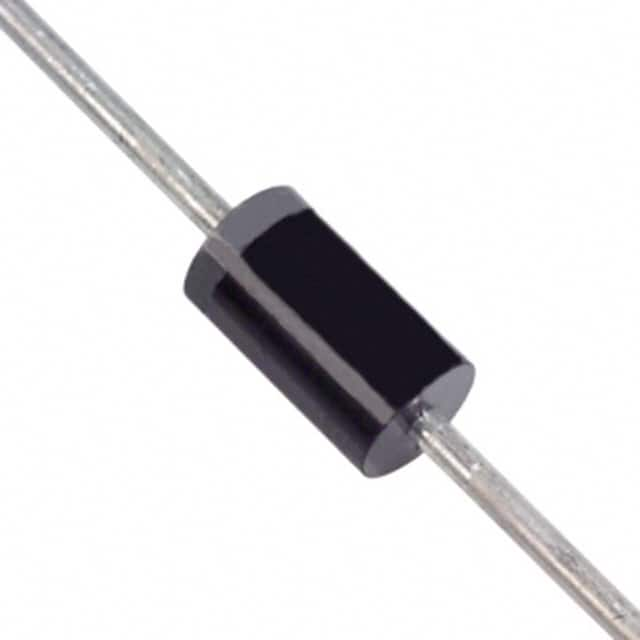1N4761A-T
Product Overview
Category
The 1N4761A-T belongs to the category of Zener diodes.
Use
It is commonly used for voltage regulation and voltage reference applications.
Characteristics
- Zener voltage: 27V
- Power dissipation: 1.3W
- Package type: DO-41
- Operating temperature range: -65°C to +200°C
- Tolerance: ±5%
Packaging/Quantity
The 1N4761A-T is typically available in reels or bulk packaging with varying quantities, depending on the supplier.
Specifications
- Zener voltage: 27V
- Power dissipation: 1.3W
- Maximum forward voltage: 1.1V
- Reverse current: 5μA
- Temperature coefficient: 0.05%/°C
Detailed Pin Configuration
The 1N4761A-T Zener diode has two pins, anode, and cathode. The anode is connected to the positive side of the circuit, while the cathode is connected to the negative side.
Functional Features
The 1N4761A-T Zener diode provides a constant voltage output when it is operated in the reverse breakdown region.
Advantages and Disadvantages
Advantages
- Precise voltage regulation
- High power dissipation capability
- Wide operating temperature range
Disadvantages
- Limited voltage options compared to other Zener diodes
- Sensitive to temperature variations
Working Principles
When the voltage across the Zener diode reaches its specified Zener voltage, it starts conducting in the reverse direction, maintaining a nearly constant voltage drop across it.
Detailed Application Field Plans
The 1N4761A-T Zener diode finds applications in: - Voltage regulators - Overvoltage protection circuits - Voltage reference circuits - Signal clamping circuits
Detailed and Complete Alternative Models
Some alternative models to the 1N4761A-T include: - 1N4749A-T (24V Zener voltage) - 1N4756A-T (39V Zener voltage) - BZX55C27-T (27V Zener voltage)
In conclusion, the 1N4761A-T Zener diode is a reliable component for voltage regulation and reference applications, offering precise voltage control and high power dissipation capabilities. Its wide operating temperature range makes it suitable for various electronic circuits and systems.
Word count: 320
Lista 10 Vanliga frågor och svar relaterade till tillämpningen av 1N4761A-T i tekniska lösningar
What is the 1N4761A-T diode used for?
- The 1N4761A-T diode is commonly used as a voltage regulator or overvoltage protection in various technical solutions.
What is the maximum forward voltage of the 1N4761A-T diode?
- The maximum forward voltage of the 1N4761A-T diode is typically around 1.0V at a forward current of 10mA.
What is the maximum reverse voltage of the 1N4761A-T diode?
- The maximum reverse voltage of the 1N4761A-T diode is 82V.
How does the 1N4761A-T diode provide overvoltage protection?
- The 1N4761A-T diode conducts when the voltage across it exceeds its breakdown voltage, effectively shunting excess voltage to protect downstream components.
Can the 1N4761A-T diode be used in rectifier circuits?
- Yes, the 1N4761A-T diode can be used in rectifier circuits due to its ability to conduct in one direction.
What is the power dissipation of the 1N4761A-T diode?
- The power dissipation of the 1N4761A-T diode is typically around 1.0W.
Is the 1N4761A-T diode suitable for high-frequency applications?
- The 1N4761A-T diode is not typically recommended for high-frequency applications due to its relatively slow switching characteristics.
What is the temperature range for the 1N4761A-T diode?
- The 1N4761A-T diode is typically rated for operation within a temperature range of -65°C to 175°C.
Can multiple 1N4761A-T diodes be connected in series for higher voltage applications?
- Yes, multiple 1N4761A-T diodes can be connected in series to achieve higher breakdown voltages.
Are there any common failure modes associated with the 1N4761A-T diode?
- Common failure modes include thermal runaway under high current conditions and breakdown due to excessive reverse voltage. Proper heat sinking and voltage regulation should be employed to mitigate these risks.


